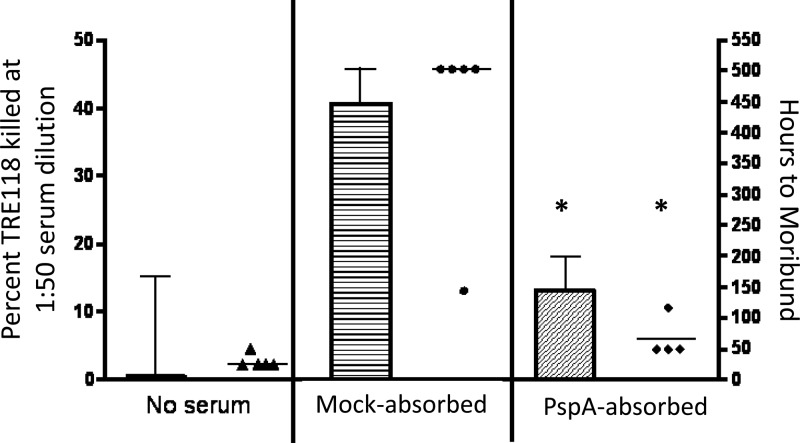Fig 5.
Adsorption of normal human serum with rPspA Sepharose removes its antipneumococcal activity in OPKA-2B against TRE118 target strains and in passive protection against fatal infection. The normal human serum sample J3, also depicted in Fig. 2C, was adsorbed with rPspA Sepharose 4B. The adsorption also resulted in a dilution that reduced the serum concentration to 61% of its original concentration. Correcting for this dilution, the adsorption removed 97.3% of the antibodies to PspA and none of the IgG antibodies to type 3 PS (data not shown). A mock adsorption with BSA-conjugated Sepharose 4B resulted in the same dilution but did not remove Abs to PspA (data not shown). Shown is the mean percent killing and standard error of TRE118 in the OPKA-2B for the no-serum control (Ringer's diluent), the mock-adsorbed serum, and the PspA-adsorbed serum in the bar graphs. A passive protection study was also conducted with Ringer's lactate, mock-adsorbed serum, and PspA-adsorbed serum using 5 mice per group. Each mouse was given 100 μl of a 1:10 dilution of the indicated serum intraperitoneally (i.p.) 1 h prior to i.v. injection of CBA/N mice with 500 CFU of strain A66.1 type 3 S. pneumoniae. The time to moribund is depicted for each mouse as individual data points. The study was terminated at 510 h postchallenge, and all surviving mice are plotted at 510 h. The postadsorption sera showed significantly (*) less killing in the modified OPKA (P = 0.019) and in passive protection (P = 0.02) than did the serum adsorbed with BSA Sepharose.

